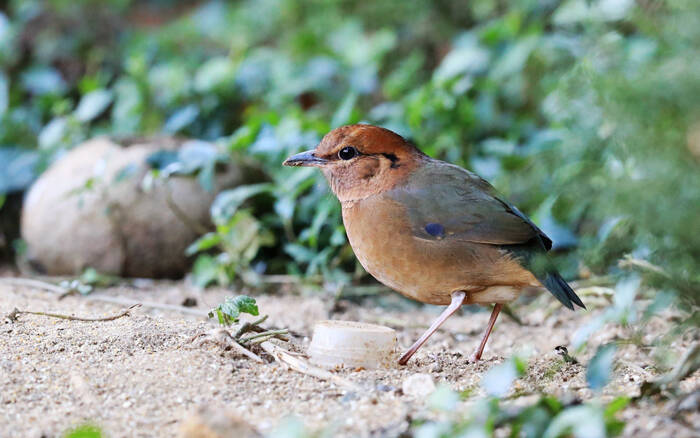Pitta oatesi
IUCN
LCBasic Information
Scientific classification
- name:Pitta oatesi
- Scientific Name:Pitta oatesi,Rusty-naped Pitta,Guoba Que
- Outline:Songbird
- Family:Passeriformes Pittidae Pitt
Vital signs
- length:23-26cm
- Weight:100-135g
- lifetime:9-11years
Feature
The call is simple and mournful, and the head is chestnut brown.
Distribution and Habitat
Distributed in Myitkyina in northeastern Myanmar to Bago and Tanassa Forest in the south, southern Shan State in the east to northern and western Vietnam in Indochina, northeastern and central Laos, northern Thailand, and the Malay Peninsula. In China, it is distributed in Yingjiang, Luxi, Menglian, Menghai, Pingbian, Luchun, Hekou, Maguan and other places in Yunnan.
It lives in tropical areas below 1,800 meters above sea level, and forages in the shade and wet places under dense evergreen broad-leaved forests.
Appearance
The body color of the chestnut-headed thrush is not as bright as other thrushes. The top of the head to the back of the neck is bright golden chestnut, which is obviously different from other thrushes. The top of the head, sides of the head, pillow, neck, back of the neck and other parts of the head are bright golden maroon. There is a black stripe behind the eye, which is mostly hidden and not visible. The eyes are dark brown. The coverts and inner flight feathers on the back, shoulders and wings are copper. Green and rich in metallic luster. The back is copper-green with dark brown sagittal markings, and the waist is blue, which is brighter and rich in metallic luster. The forehead, chin, throat and upper chest are burgundy red, and the lower body is dark brown. The body color of the female bird is similar to that of the male bird, but the color is not as bright as the male bird.
The iris is brownish red or reddish brown; the upper mouth is black and the lower mouth is yellowish b
Details
The Rusty-naped Pitta is called Rusty-naped Pitta in English, and has 4 subspecies.

The Chestnut-headed Pitta does not form groups, and is seen alone or in pairs in winter or summer. The legs are long and strong, and they are good at running and jumping. They frequently use their feet to turn over the dead branches and leaves on the ground to find food. They feed on insects of the Coleoptera family and the family of Curculionidae, ants of the Hymenoptera, earthworms, termites, as well as seeds and fruits and other animal foods.
The breeding season of the Chestnut-headed Pitt varies from region to region. In Myanmar, the egg-laying season is mainly from May to July, in Thailand it is from August to September, and in the Indian subcontinent it is from mid-September to October at the latest. Generally, it chooses the middle or end of the rainy season. Most nests are built in high-humidity forests, on mosses and ferns on very deep and steep gullies, rocky cliffs, and boulders in the forest area.
Chestnut-headed Pitta usually nests on the ground in bamboo forests, secondary forests or shrubs, and rarely in dense forests. But some nests are built on trees, with the entrance facing the tree, and only part of the nest can be approached. This allows adult birds to monitor potential intruders and escape quickly in the face of danger. The nest placed on the tree is about 50 cm wide, 20 cm deep, and the diameter of the entrance is 9 cm. The built nest is like a loose ball with an entrance. The structure is relatively rough, mainly composed of twigs, bamboo leaves, mosses, lichens, grass stems and roots. The nest entrance is mostly opened near the ground, and there are usually many hidden objects such as fallen leaves or other debris to bury the nest. In areas dominated by bamboo, bamboo leaves account for a large proportion of the main building materials for nest construction. The nests are placed at different heights from the ground, ranging from 2.50 meters to 4 meters. Each nest lays 4-5 eggs, up to 7 eggs. The color varies from light red, dark purple or white. The male and female build the nest together, incubate and feed the chicks. The incubation lasts about 17 days.
Listed in the 2013 Red List of Endangered Species of the World Conservation Union (IUCN) ver 3.1 - Least Concern (LC).
Listed in the second level of the List of Key Protected Wildlife in China.
Protect wild animals and stop eating game.
Maintaining ecological balance is everyone's responsibility!








